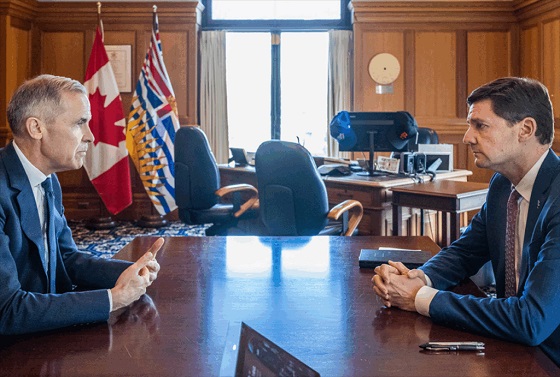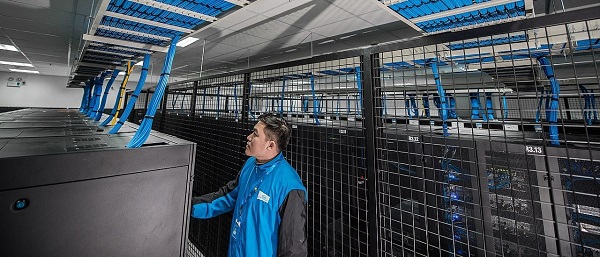Business
Premiers Rally For Energy Infrastructure To Counter U.S. Tariff Threats
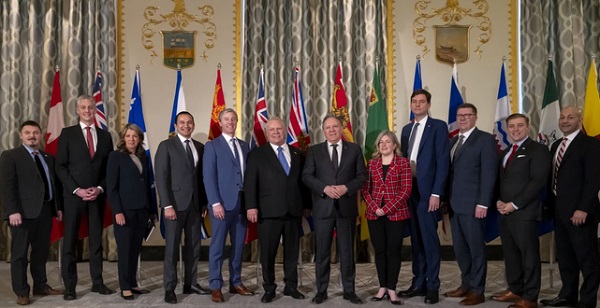
From the Frontier Centre for Public Policy
With U.S. tariffs looming, Premiers push for border security, pipelines, and interprovincial trade reform
After more than eight years of federal policies that have challenged the oil and gas industry, imagining Canadian energy policy in a post-Trudeau era is no easy task.
However, recent meetings addressing the threat of United States tariffs may offer hope for revisiting energy policies through provincial collaboration.
The January 2025 Council of the Federation meetings, attended by all 13 provincial and territorial premiers, produced several key value propositions.
- After spending a week in Washington, D.C., meeting with Donald Trump and his administration, Alberta Premier Danielle Smith highlighted the provinces’ resource strengths.
- British Columbia can leverage germanium—a critical mineral essential in defence applications that China will no longer export to the U.S.
- Saskatchewan’s uranium supply offers an alternative to reliance on Kazakhstan and Russia.
- Canadian provinces can provide resources that align with U.S. energy goals.
Any provincial initiatives must also address U.S. priorities, including tighter border security and increased defence spending.
To meet U.S. energy security needs, Canada must remove policy barriers hindering development. Policies like the Clean Energy Regulations (CER), the emissions cap, and the net-zero vehicle mandate (starting January 2026) are significant challenges. Provinces must collaborate to amend or remove these policies, ensuring they do not survive the next federal election. Alberta and Saskatchewan have already opposed the CER, and the proposed emissions cap remains under review.
The federal government acknowledges that these policies must be re-evaluated to avoid obstructing shared energy goals, including:
- carbon pollution pricing
- methane regulations
- clean fuel standards
- carbon capture incentives
- emissions reduction funding
- clean growth programs
- best-in-class guidelines for new oil and gas projects under federal review.
The U.S.’s energy deficit—20 million barrels consumed daily versus 13 million produced—creates an opportunity for Canada. Achieving this requires dismantling interprovincial trade barriers and developing infrastructure projects from coast to coast. The Council meetings have initiated such collaboration, with ongoing bilateral discussions expected. Infrastructure projects like pipelines to the East and West coasts would enable Canada to supply the U.S. and other global markets, reducing reliance on hostile regimes.
Newfoundland and Labrador Premier Andrew Furey stated: “I see energy as Canada’s queen in the game of chess. We don’t need to expose our queen this early. The opposition needs to know that the queen exists, but they don’t need to know what we’re going to do with the queen.”
Saskatchewan Premier Scott Moe and Alberta Premier Danielle Smith have rejected measures that would affect Canada’s energy exports to the U.S.
“When you look at the pipeline system, how oil is actually transported into the U.S. and back into Canada,” Moe said, “it would be very difficult, and I think impossible operationally to even consider.” Manitoba Premier Wab Kinew emphasized the importance of national unity, stating that energy decisions must not fracture the country. Ontario Premier Doug Ford warned that tariffs could cost Ontario 500,000 jobs, while P.E.I. Premier Dennis King noted that tariffs could cost 25 per cent of P.E.I.’s GDP and 14,000 jobs—a catastrophic loss for the province.
The Council meetings highlighted three key priorities:
- Demonstrate Canada’s commitment to border security and meet its two per cent GDP NATO target.
- Build oil and gas pipelines east and west to diversify markets and remove interprovincial trade barriers, enabling a stronger national economy.
- Secure provincial consent before imposing export tariffs or restrictions that could harm individual provinces.
This emerging consensus underscores that Canada’s energy future depends on proactive, constructive diplomacy with U.S. lawmakers, supported by a unified provincial front and practical energy policies that benefit both nations.
Maureen McCall is an energy business analyst and Fellow at the Frontier Center for Public Policy. She writes on energy issues for EnergyNow and the BOE Report. She has 20 years of experience as a business analyst for national and international energy companies in Canada.
Business
Canada is failing dismally at our climate goals. We’re also ruining our economy.

From the Fraser Institute
By Annika Segelhorst and Elmira Aliakbari
Short-term climate pledges simply chase deadlines, not results
The annual meeting of the United Nations Conference of the Parties, or COP, which is dedicated to implementing international action on climate change, is now underway in Brazil. Like other signatories to the Paris Agreement, Canada is required to provide a progress update on our pledge to reduce greenhouse gas (GHG) emissions by 40 to 45 per cent below 2005 levels by 2030. After decades of massive government spending and heavy-handed regulations aimed at decarbonizing our economy, we’re far from achieving that goal. It’s time for Canada to move past arbitrary short-term goals and deadlines, and instead focus on more effective ways to support climate objectives.
Since signing the Paris Agreement in 2015, the federal government has introduced dozens of measures intended to reduce Canada’s carbon emissions, including more than $150 billion in “green economy” spending, the national carbon tax, the arbitrary cap on emissions imposed exclusively on the oil and gas sector, stronger energy efficiency requirements for buildings and automobiles, electric vehicle mandates, and stricter methane regulations for the oil and gas industry.
Recent estimates show that achieving the federal government’s target will impose significant costs on Canadians, including 164,000 job losses and a reduction in economic output of 6.2 per cent by 2030 (compared to a scenario where we don’t have these measures in place). For Canadian workers, this means losing $6,700 (each, on average) annually by 2030.
Yet even with all these costly measures, Canada will only achieve 57 per cent of its goal for emissions reductions. Several studies have already confirmed that Canada, despite massive green spending and heavy-handed regulations to decarbonize the economy over the past decade, remains off track to meet its 2030 emission reduction target.
And even if Canada somehow met its costly and stringent emission reduction target, the impact on the Earth’s climate would be minimal. Canada accounts for less than 2 per cent of global emissions, and that share is projected to fall as developing countries consume increasing quantities of energy to support rising living standards. In 2025, according to the International Energy Agency (IEA), emerging and developing economies are driving 80 per cent of the growth in global energy demand. Further, IEA projects that fossil fuels will remain foundational to the global energy mix for decades, especially in developing economies. This means that even if Canada were to aggressively pursue short-term emission reductions and all the economic costs it would imposes on Canadians, the overall climate results would be negligible.
Rather than focusing on arbitrary deadline-contingent pledges to reduce Canadian emissions, we should shift our focus to think about how we can lower global GHG emissions. A recent study showed that doubling Canada’s production of liquefied natural gas and exporting to Asia to displace an equivalent amount of coal could lower global GHG emissions by about 1.7 per cent or about 630 million tonnes of GHG emissions. For reference, that’s the equivalent to nearly 90 per cent of Canada’s annual GHG emissions. This type of approach reflects Canada’s existing strength as an energy producer and would address the fastest-growing sources of emissions, namely developing countries.
As the 2030 deadline grows closer, even top climate advocates are starting to emphasize a more pragmatic approach to climate action. In a recent memo, Bill Gates warned that unfounded climate pessimism “is causing much of the climate community to focus too much on near-term emissions goals, and it’s diverting resources from the most effective things we should be doing to improve life in a warming world.” Even within the federal ministry of Environment and Climate Change, the tone is shifting. Despite the 2030 emissions goal having been a hallmark of Canadian climate policy in recent years, in a recent interview, Minister Julie Dabrusin declined to affirm that the 2030 targets remain feasible.
Instead of scrambling to satisfy short-term national emissions limits, governments in Canada should prioritize strategies that will reduce global emissions where they’re growing the fastest.

Elmira Aliakbari
Artificial Intelligence
Lawsuit Claims Google Secretly Used Gemini AI to Scan Private Gmail and Chat Data

Whether the claims are true or not, privacy in Google’s universe has long been less a right than a nostalgic illusion.
|
When Google flipped a digital switch in October 2025, few users noticed anything unusual.
Gmail loaded as usual, Chat messages zipped across screens, and Meet calls continued without interruption.
Yet, according to a new class action lawsuit, something significant had changed beneath the surface.
We obtained a copy of the lawsuit for you here.
Plaintiffs claim that Google silently activated its artificial intelligence system, Gemini, across its communication platforms, turning private conversations into raw material for machine analysis.
The lawsuit, filed by Thomas Thele and Melo Porter, describes a scenario that reads like a breach of trust.
It accuses Google of enabling Gemini to “access and exploit the entire recorded history of its users’ private communications, including literally every email and attachment sent and received.”
The filing argues that the company’s conduct “violates its users’ reasonable expectations of privacy.”
Until early October, Gemini’s data processing was supposedly available only to those who opted in.
Then, the plaintiffs claim, Google “turned it on for everyone by default,” allowing the system to mine the contents of emails, attachments, and conversations across Gmail, Chat, and Meet.
The complaint points to a particular line in Google’s settings, “When you turn this setting on, you agree,” as misleading, since the feature “had already been switched on.”
This, according to the filing, represents a deliberate misdirection designed to create the illusion of consent where none existed.
There is a certain irony woven through the outrage. For all the noise about privacy, most users long ago accepted the quiet trade that powers Google’s empire.
They search, share, and store their digital lives inside Google’s ecosystem, knowing the company thrives on data.
The lawsuit may sound shocking, but for many, it simply exposes what has been implicit all along: if you live in Google’s world, privacy has already been priced into the convenience.
Thele warns that Gemini’s access could expose “financial information and records, employment information and records, religious affiliations and activities, political affiliations and activities, medical care and records, the identities of his family, friends, and other contacts, social habits and activities, eating habits, shopping habits, exercise habits, [and] the extent to which he is involved in the activities of his children.”
In other words, the system’s reach, if the allegations prove true, could extend into nearly every aspect of a user’s personal life.
The plaintiffs argue that Gemini’s analytical capabilities allow Google to “cross-reference and conduct unlimited analysis toward unmerited, improper, and monetizable insights” about users’ private relationships and behaviors.
The complaint brands the company’s actions as “deceptive and unethical,” claiming Google “surreptitiously turned on this AI tracking ‘feature’ without informing or obtaining the consent of Plaintiffs and Class Members.” Such conduct, it says, is “highly offensive” and “defies social norms.”
The case invokes a formidable set of statutes, including the California Invasion of Privacy Act, the California Computer Data Access and Fraud Act, the Stored Communications Act, and California’s constitutional right to privacy.
Google is yet to comment on the filing.
|
|
|
|
Reclaim The Net is reader-supported. Consider becoming a paid subscriber.
|
|
|
|
-

 Crime19 hours ago
Crime19 hours ago‘Modern-Day Escobar’: U.S. Says Former Canadian Olympian Ran Cocaine Pipeline with Cartel Protection and a Corrupt Toronto Lawyer
-

 Health2 days ago
Health2 days agoNEW STUDY: Infant Vaccine “Intensity” Strongly Predicts Autism Rates Worldwide
-
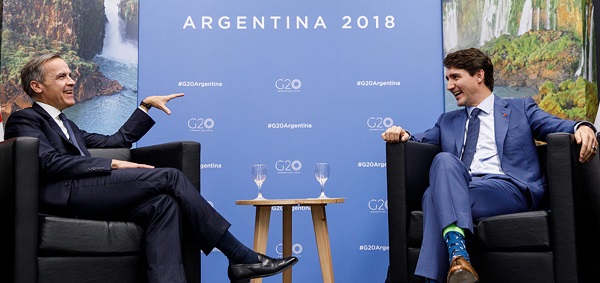
 Carbon Tax2 days ago
Carbon Tax2 days agoCarney fails to undo Trudeau’s devastating energy policies
-
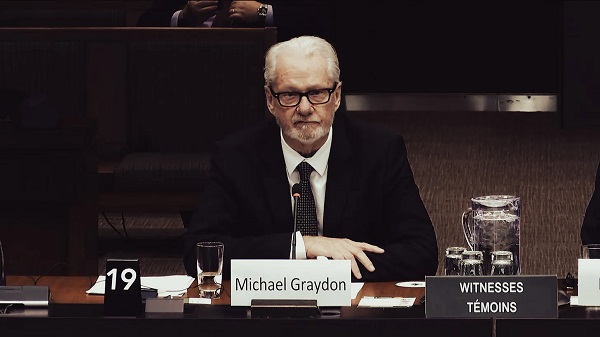
 Business1 day ago
Business1 day agoNearly One-Quarter of Consumer-Goods Firms Preparing to Exit Canada, Industry CEO Warns Parliament
-

 Daily Caller1 day ago
Daily Caller1 day agoDemocrats Explicitly Tell Spy Agencies, Military To Disobey Trump
-

 Addictions2 days ago
Addictions2 days agoActivists Claim Dealers Can Fix Canada’s Drug Problem
-
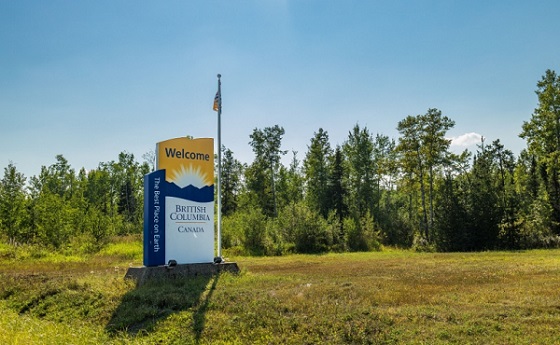
 Indigenous1 day ago
Indigenous1 day agoTop constitutional lawyer slams Indigenous land ruling as threat to Canadian property rights
-

 Alberta2 days ago
Alberta2 days agoEdmonton and Red Deer to Host 2027 IIHF World Junior Hockey Championship



